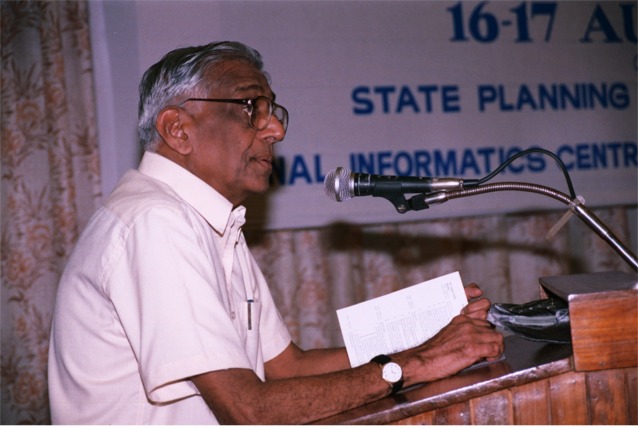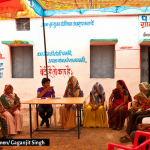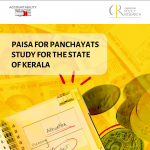
A Role Model Slips Away
8 December 2015
It was at a conference in Kerala, probably in 2003 or so, that I first met him.
Vijayanand, my friend and fellow traveller on the road to democratic decentralisation, grabbed me by the arm and took me to the table where the gaunt man was having lunch. ‘This is Raghunandan,’ he introduced me.
Mr. V. Ramachandran was already a legend, as far as I was concerned. He had had a stellar career in the Indian Administrative Service, which he had joined in 1953. Later on in his career, he served under two Prime Ministers of India, Indira Gandhi and Morarji Desai, as Joint Secretary in the Prime Minister’s Secretariat. A few years later, he became the Chief Secretary of Kerala State and served with distinction for several years, handing over, incidentally, to Ms. Padma Ramachandran, the first woman to become Chief Secretary of Kerala. Prior to that, he was known for his work in strengthening the electricity board in Kerala and as the Finance Secretary of the State as well. Any officer with as distinguished a career record as he had, would have rested on his laurels. But that was not in his nature; he was made of sterner stuff. From 1991 to 1996 and later, from 2001 to 2005, Mr. Ramachandran served as vice-Chairperson of the Kerala State Planning Board.
Kerala’s bold experiment in 1996, perhaps the closest that any Indian State has come to truly implementing the constitutional ideal of democratic decentralisation, was anchored by Mr. Ramachandran. True, a bureaucrat can do precious little in furthering the vigour of democracy if there is no political will. Mr. Ramachandran was an ideal foil to E.M.S. Namboodiripad, who provided the vision for Kerala’s bold move. E.M.S., in the evening of his life and as the grandmaster of leftist political thinking in Kerala, pushed for Kerala’s decentralisation. Not all of his party members shared the same enthusiasm, but there were enough of them, to provide the serious political impetus to this decision. As the Deputy-Chairperson during the left front government, Mr. Ramachandran guided the internal process of change, standing by decisions that other bureaucrats considered risky, dismantling budgets, removing constraints and providing the flexibility and money necessary for people to see credibility in local planning. Vijayanand, who worked in that period as the Secretary in the Local self-government department in Kerala, was Mr. Ramachandran’s protégé.
My boss in Delhi, Mr. Wajahat Habibullah, was the one who played a master stroke. Our task in the newly created Ministry of Panchayati Raj was to draft policy that would redraw the lines of engagement between the Union Government and Local Governments. It was a strategy fraught with political and constitutional implications. Under India’s federal constitution, it is the States that are to determine the pattern of decentralisation to local governments and a centralised approach would be misunderstood. Mr. Habibullah, the Secretary of the Ministry, conscious of this sensitivity, needed allies in his task of chivvying the States to make haste in devolving powers and responsibilities to the Panchayats. He looked towards the Planning Commission and suggested that the politically acceptable way to get States to move in this direction, is to promote the idea of decentralised participatory planning; States would not resist this approach.
As Secretary of Rural Development and Panchayati Raj in Karnataka, it was the Kerala experiment that was the gold standard, the model to be emulated. Little doubt therefore, that I was in awe of Mr. Ramachandran. I remember very little about that meeting, except that Mr. Ramachandran fixed me with his stare and told me that he had heard a lot from Vijayanand about me. I mumbled a few words in acknowledgement.
In a few years I was catapulted to the Union Government, to serve as Joint Secretary in the Ministry of Panchayati Raj, an opportunity that I grabbed with both hands. In the tumultuous years from 2001 to 2004, under the tutelage of Mr. M.Y. Ghorpade, I was able to contribute to strengthening Panchayats in Karnataka, taking a leaf from the book of Kerala. I saw the opportunity to serve in Delhi as a way to carry the decentralisation story forward, across the country. It was a time when adrenalin flowed, dreams and hopes ran high.
The vision of participatory planning was a grand one. It was envisaged that India’s visioning and planning would begin with peoples assemblies; Gram Sabhas, in rural areas and Wards Committees in urban areas. Village level Panchayats would prepare plans for their areas in consultation with Gram Sabhas. Municipalities would do likewise in their areas. The District and Intermediate level Panchayats would prepare plans for their functional domains and local government plans would be consolidated into district plans, by the District Planning Committees. These, in turn would form a major component of State Plans and they in turn, would comprise a large part of the national plan. The key to this idea was that each level of government would plan strictly in accordance with the principle of subsidiarity; that everything ought to be done at the lowest level practicable, and at no other level. A high level vision document, capturing and giving shape to this grand vision, was required. Who else but Mr. Ramachandran, to lead this effort?
Following consultations with the Planning Commission, Mr. Habibullah constituted an Expert Group headed by Mr. Ramachandran, to develop the contours of an operational process for turning national planning on its head. The Group has a stellar cast; the other members were Mr. B.N. Yugandhar, Member, Planning Commission, Mr. D. Bandyopadhya, Former Secretary, Government of India, Ministry of Rural Development, Ms. Nirmala Buch, Former Secretary, Government of India, Ministry of Rural Development, Dr. Devaki Jain, Development Economist and Dr. Govinda Rao, Director, National Institute of Public Finance &Policy. I was made the Secretary to the Group.
‘It’s not easy, he is tough, meticulous and demands a high level of commitment and attention to detail,’ said Vijayanand, my friend. I steeled myself for the challenge.





